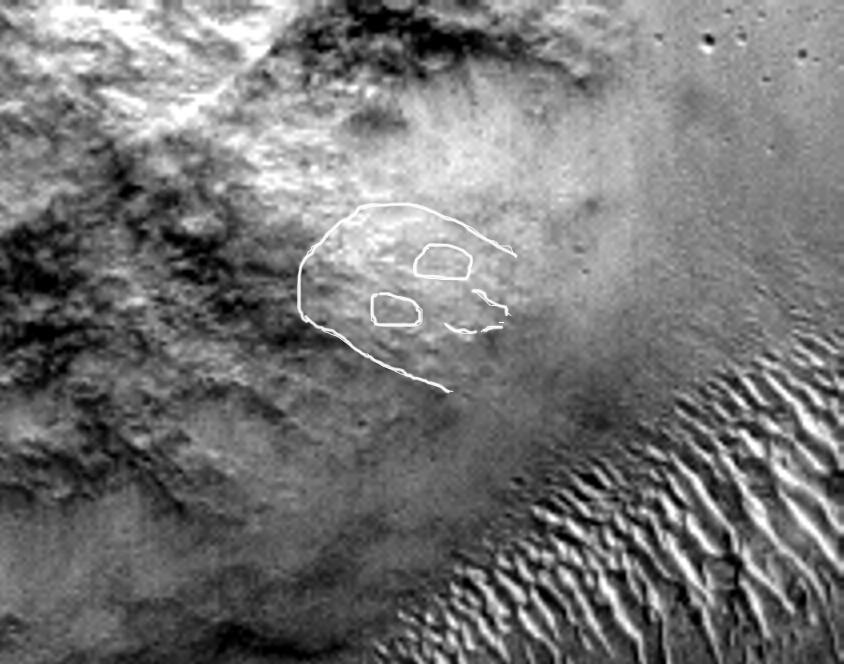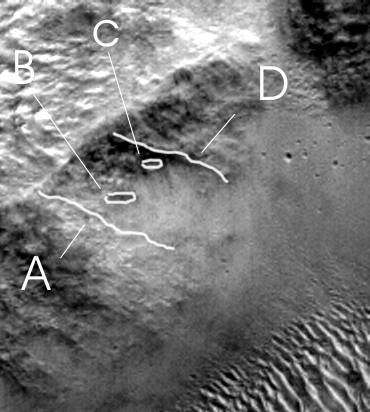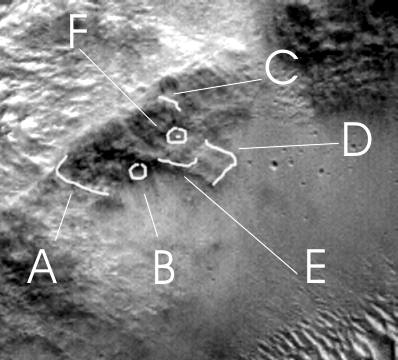
Other faces

Since there may be 3 interlocked faces (explained here) it's possible this technique may have been used more extensively. The rounded nature of the cliff face makes it possible that if the sun moved from say left to right then one face at a time might have been illuminated. Faces to either side might have been either in shadow or so illuminated they throw no shadows to be visible. After all, if a hypothetical builder did this with 3 faces there is no reason why he couldn't have done it with more. There is little real evidence at this resolution, but it may be useful to make a prediction for later images. It also helps to see if these are indeed tricks of light and shadow or are real. If more detailed images show the faces become clearer it is strong evidence for artificiality. If the faces dissipate then it is evidence they are natural.

A represents a ledge, and with the sun coming from the right would show an edge of a face. B would represent a nose shape here, and there appears to be 2 faint nostril shapes at its end. C represents an eye shape over the right eye of the face to the left, which is a recurrent pattern with the 3 main interlocked faces. D represents an oval depression with a lighter area in the center like a pupil. D also has a very similar shape to the 3 right eyes of the 3 main interlocked faces. There is no evidence of a mouth or chin, but much of the lower part of this cliff seems to be buried, indicating the faces (if real) are extremely ancient. So this face candidate represents a recurrence of the same motifs for the left and right eye, and the nose. Since these features are not known to repeat for geological reasons they may be additional evidence.

At A there may be another eye, which is a recurring motif of one eye above and to the side of another. The ridge at B would cast a shadow like an eye, though there appears to be no pupil. C would catch the shadow as a nose, though no nostrils appear to be visible. E gives a suggestion of a chin or jawline, and no mouth is obvious except for perhaps a shadow from F.
Another face may be here:

 Another possibility. A represents a ridge
which could define the left side of a face. B and C are eye shaped and
dissimilar to crater shapes. D represents another ridge which could throw a
shadow and define the right side of the face. Again there seems to be no
evidence of a nose, mouth and little of a chin but this area also seems buried
in soil. Of for example the rest of the face did not appear buried then this
absence of features would argue it was not a face, and that face shapes might be
occurring by chance.
Another possibility. A represents a ridge
which could define the left side of a face. B and C are eye shaped and
dissimilar to crater shapes. D represents another ridge which could throw a
shadow and define the right side of the face. Again there seems to be no
evidence of a nose, mouth and little of a chin but this area also seems buried
in soil. Of for example the rest of the face did not appear buried then this
absence of features would argue it was not a face, and that face shapes might be
occurring by chance.

There are other smaller faces in this area, but probably too small to see features clearly.